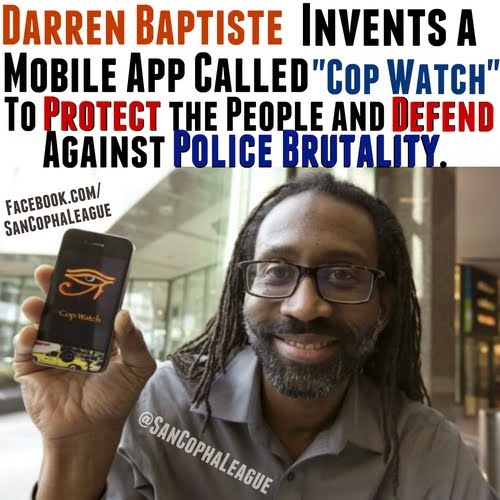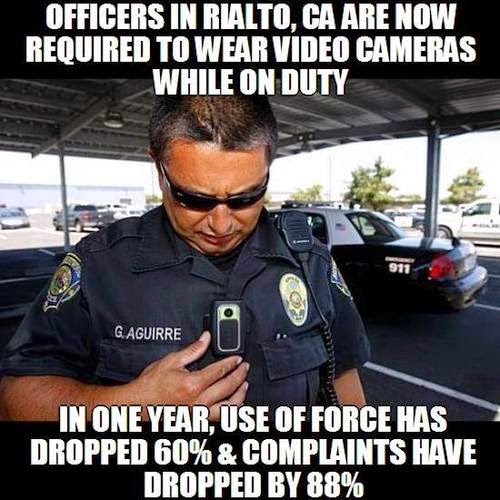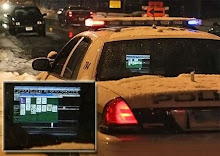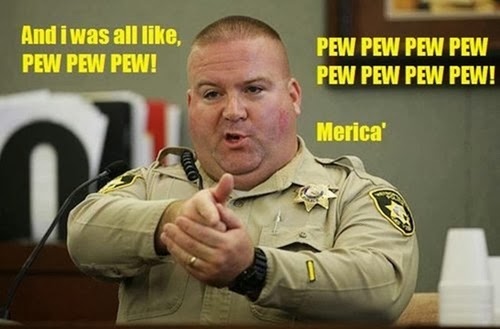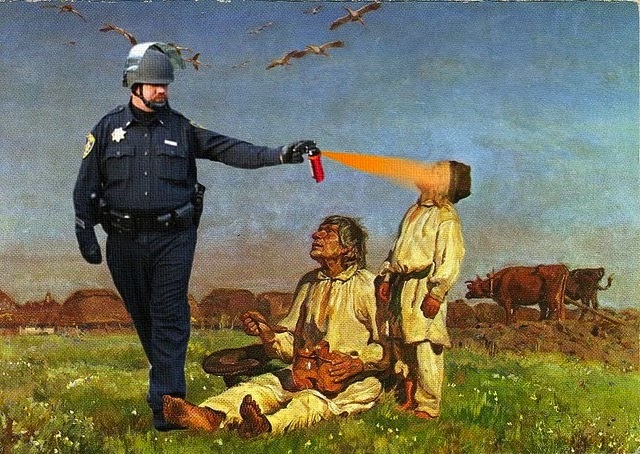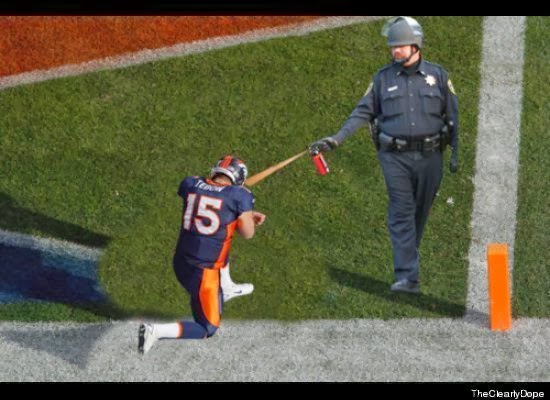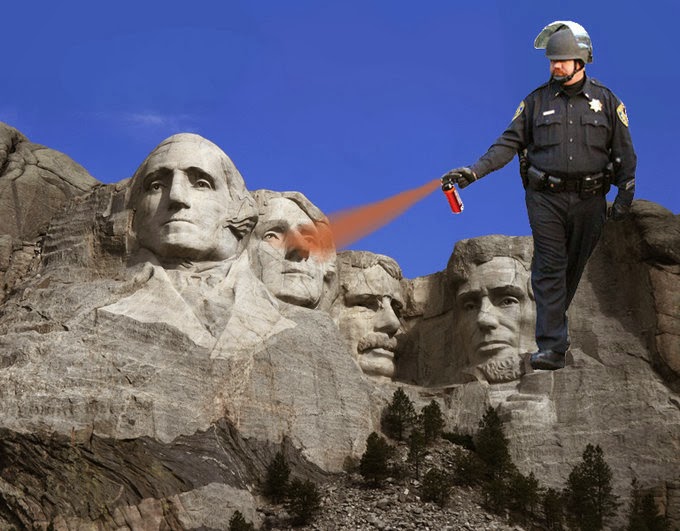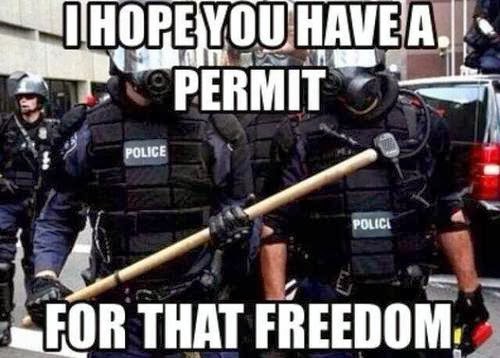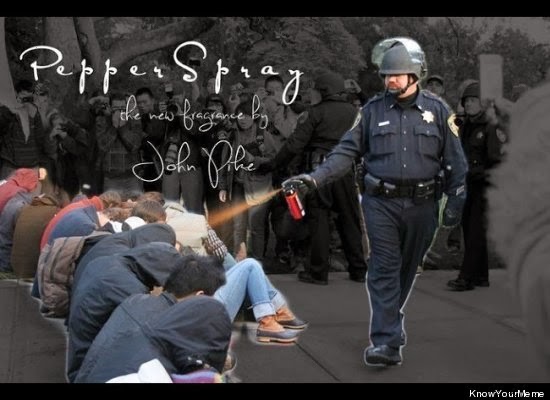Unreasonable force (That you paid for out of the taxpayers pockets)
Clem v. COUNTY OF FAIRFAX, VA, 150 F. Supp. 2d 888 (E.D. Va. 2001)
U.S. District Court for the Eastern District of
Virginia - 150 F. Supp. 2d 888 (E.D. Va. 2001)
July 17, 2001
150 F. Supp. 2d 888
(2001)
Robert CLEM,
Plaintiff,
v.
COUNTY OF FAIRFAX, VIRGINIA, et al., Defendants.
No. CIV. A. 00-1684-A.
United States District Court, E.D. Virginia, Alexandria Division.
July 17, 2001.
*889 Brien Anthony Roche, Johnson & Roche,
McLean, VA, for plaintiff.
Cynthia L. Tianti,
Assist. County Atty., Fairfax, VA, for defendants.
MEMORANDUM OPINION
ELLIS, District Judge.
This action is a Section
1983[1] excessive use of force, gross negligence,
and assault and battery suit brought by plaintiff Robert Clem, a 58-year-old
male who suffers from depression and dementia, against defendants County of
Fairfax, the County's Chief of Police, and two individual officers, Shannon
Corbeau and Eric Nelson. Following a hearing, summary judgment was entered in
favor of all defendants, except Officer Corbeau.[2] Cross-motions for summary judgment relating to Officer
Corbeau were denied on the ground that triable issues of fact remained
with respect to whether Officer Corbeau is entitled to qualified immunity for
his actions in shooting plaintiff three times.[3] Plaintiff subsequently filed a motion to alter or amend this
ruling. This Memorandum Opinion sets forth the reasons for the denial of
summary judgment for Officer Corbeau on qualified immunity grounds and also
resolves plaintiff's motion to alter or amend.
On November 9, 1998,
plaintiff's wife called 911 and advised the dispatcher that plaintiff, who had
mental problems, had not eaten in three days, was refusing to go to his
doctor's appointment, was urinating on the floor, and was dropping lighted
cigarettes on the floor. The dispatcher labeled the call a "mental
case," and Officers Corbeau and Nelson responded. Before entering
plaintiff's residence, Officer Nelson informed Officer Corbeau that
approximately six weeks earlier, Officer Nelson and another officer had
responded to a similar call from plaintiff's wife, who complained that
plaintiff had threatened her with a knife. On this earlier occasion, the
officers were able to persuade plaintiff to attend his scheduled doctor's
appointment.
When the officers
entered the residence, plaintiff was seated at the kitchen table. Officer
Corbeau testified that plaintiff appeared "slightly out of it." Once
inside, Officer Nelson attempted to persuade plaintiff to keep his doctor's
appointment. These efforts, at least initially, were successful, as plaintiff
stated that he was willing to keep the appointment. Accordingly, Officer Nelson
assumed the situation was under control, and called off the units en route to
provide back-up support.
Then, the situation
changed abruptly. Plaintiff changed his mind about keeping his doctor's
appointment. In response, both officers renewed their efforts to encourage
plaintiff to see his doctor. Officer Corbeau testified that plaintiff responded
by stating he would kill Officer Corbeau and while patting his front right
pants pocket, plaintiff further declared that he had "something that could
beat anything that [Corbeau] had on his belt." Plaintiff's nephew, who was
present at the time, disputed Officer Corbeau on this point. He stated,
instead, that plaintiff never threatened the officers, but did pat his pocket
and state that "you think that I am afraid of you because of your
badge." Mrs. Clem also disputed Officer Corbeau's testimony on this point;
she agreed with the nephew's account that plaintiff never threatened either
Officer Corbeau or Officer Nelson. Officer Nelson supported Officer Corbeau's
testimony, although his support is arguably contradicted by the first statement
he provided in the course of an interview on the date of the shooting. In that
interview, Officer Nelson never mentioned that plaintiff had patted his pocket
or threatened defendant. Later that day, however, Officer Nelson did confirm
Officer Corbeau's version of plaintiff's statement. Yet, significantly, during
this same interview, Officer Nelson also stated that he was certain that
plaintiff was unarmed, despite plaintiff's threat, because plaintiff's shirt
was open and he could see that plaintiff had no weapons in his front pocket or
tucked into his waistband.
Immediately following
the disputed statement, plaintiff, with no warning, jumped out of his seat and
with his arms up in the air began moving toward Officer *891 Corbeau.
Plaintiff's wife and Officer Nelson attempted unsuccessfully to restrain him.
Officer Corbeau, in response, used his pepper spray on plaintiff because he
felt that plaintiff "posed an immediate threat of serious bodily
injury."[4] As it happened, the pepper spray also
struck Officer Nelson, plaintiff's wife, and plaintiff's nephew. Because it
appeared that the pepper spray had momentarily stopped the plaintiff, Officer
Nelson directed plaintiff's nephew to escort plaintiff's wife to the bathroom
to wash her face, and Officer Nelson then went to the front door to radio for
additional support.
After being sprayed with
pepper spray in the breakfast area by Corbeau, plaintiff entered the living
room area where Officer Corbeau was located. When Officer Nelson returned from
his radio call, plaintiff began moving toward him. Officer Nelson stated that
plaintiff used profanity and swung his arms "like he [was] reaching out to
punch [me]." Officer Nelson pulled out his pepper spray and repeatedly
warned plaintiff to keep his distance. According to Officer Nelson, these
warnings went unheeded and although he backed away from plaintiff, plaintiff
attempted to strike Officer Nelson.[5] Officer Nelson
deflected the attempt and then used his pepper spray on plaintiff.[6]
Following this,
plaintiff began moving toward Officer Corbeau, who retreated by moving into a
hallway that connected to the living room. Officer Corbeau described
plaintiff's movement toward him as extremely fast, his countenance as snarling,
his eyes as bulging out, and plaintiff as showing no apparent reaction to the
pepper spray. Officer Corbeau also stated that plaintiff's arms were flailing
about and that he swore that he was going to kill Officer Corbeau. Officer
Nelson corroborated Officer Corbeau's description of plaintiff's movement and
threats.[7] As plaintiff continued to approach at
Officer Corbeau, Officer Corbeau repeated his *892 warnings to
plaintiff to stop advancing.[8] By this time, Officer
Corbeau retreated approximately four feet down the approximately fifteen-foot
hallway, unholstered his gun, and shot plaintiff three times, once in the groin
and twice in the torso area. Officer Corbeau stated that he was forced to shoot
from the hip because plaintiff's proximity prevented him from extending his
arm. After being shot, plaintiff took a few steps away from Officer Corbeau and
fell onto his side.
On September 1, 2000,
plaintiff filed a three-count complaint against in the Fairfax County Circuit
Court. Count I alleges that defendants violated plaintiff's federal
constitutional rights as guaranteed by the First, Fourth, Fifth, and Fourteenth
Amendments. Counts II and III are Virginia state law claims for gross
negligence and assault and battery, respectively. On October 11, 2000,
defendants removed the case to federal court. Then, on April 13, 2001,
plaintiff filed a motion for partial summary judgment, and each defendant
responded by filing a cross-motion for summary judgment. After briefing and
oral argument, summary judgment was granted in favor of Officer Nelson, Chief
Manager, and the County of Fairfax on all counts. See Clem v. County of
Fairfax, Civ. A. No. 00-1684-A (E.D.Va. May 29, 2001) (Order). Summary
judgment was granted in favor of Officer Corbeau on the excessive force claim
relating to his use of pepper spray, but was denied in all other
respects. See id. At issue here is whether Officer Corbeau is
entitled to qualified immunity with respect to the cause of action in Count I,
which alleges that the use of deadly force in the circumstances was a violation
of plaintiff's Fourth Amendment rights.
II.
Government officials are
entitled to qualified immunity for civil damages to the extent that "their
conduct does not violate clearly established statutory or constitutional rights
of which a reasonable person would have known."[9] More specifically, "[a] police officer should prevail
on an assertion of qualified immunity if a reasonable officer possessing the
same information could have believed that his conduct was lawful."[10] And, where a defendant seeks qualified immunity, "a
ruling on that issue should be made early in the proceedings so that the costs
and expenses of trial are avoided where the defense is dispositive." Saucier
v. Katz, 533 U.S. ___, 121 S. Ct. 2151, 2156, 150 L. Ed. 2d 272
(2001).
Qualified immunity
applies only in the context of a validly alleged constitutional *893 violation.
Without such a violation, qualified immunity is obviously unnecessary; in that
event, the underlying claim would simply fail. See Siegert v.
Gilley, 500 U.S. 226, 232, 111 S. Ct. 1789, 114 L. Ed. 2d 277 (1991). Thus, the
threshold question that must be addressed before engaging in the qualified
immunity analysis is whether the facts alleged, taken in the light most
favorable to the plaintiff, establish that the officer's conduct violated a
constitutional right. See Saucier, 121 S. Ct. at
2156; Siegert, 500 U.S. at 232, 111 S. Ct. 1789. This question
is easily answered here in the affirmative, given plaintiff's allegation that
Officer Corbeau violated his Fourth Amendment right to be free from the use of
deadly force unless the "officer has sound reason to believe that a suspect
poses a threat of serious physical harm to the officer or others."[11] Specifically, plaintiff argues that Officer Corbeau shot him
(three times) under circumstances that did not warrant or justify the use of
deadly force. In this regard, plaintiff alleges that he was unarmed, that he
posed no threat of serious bodily injury to Officer Corbeau or others, and
finally, that Officer Corbeau could not and did not perceive that plaintiff
posed such a risk. These allegations, taken in the light most favorable to
plaintiff, state a valid claim for excessive use of police force in violation
of the Fourth Amendment. Given that plaintiff has alleged a valid Fourth
Amendment excessive use of deadly force claim against Officer Corbeau, it
remains to be seen whether, on the basis of the developed factual record,
Officer Corbeau is entitled to qualified immunity.
Because qualified
immunity turns on whether the officer's conduct violates a clearly defined
constitutional right of which a reasonable officer would have known, the next
step in the analysis is to define the constitutional right involved "at
the appropriate level of specificity."[12] Once this is done,
the qualified immunity analysis proceeds to ascertain whether the right so
defined was clearly established at the time of the incident. If the right was
not clearly established in the law at the time, no further inquiry is
necessary, as qualified immunity is warranted under these circumstances. See Saucier, 121
S. Ct. at 2157. But, if the right infringed was clearly established, a final
inquiry is necessary to complete the analysis. This final inquiry asks the
fact-specific question whether a reasonable officer could have believed, in the
circumstances, that his behavior was lawful.
There is no doubt that the
right at issue herethe right to be free from the use of deadly force absent a
belief by the officer that the suspect poses a threat of serious physical
harmhas long been clearly established.[13] So, then, the
final question to address is whether it would have been clear to a reasonable
officer that Officer Corbeau's use of deadly force "was unlawful in the
situation he confronted."[14]*894 To answer this final question, it is
necessary to canvass the factual record for what it discloses about what Officer
Corbeau knew and perceived at the time, for these are the predicate facts for
determining how a reasonable officer would respond in the circumstances at bar.
In the context of this case, the final question in the qualified immunity
analysis is whether or not it would have been clear to a reasonable officer
standing in Officer Corbeau's shoes at the time of the shooting that plaintiff
posed a risk of serious physical harm to Officer Corbeau or others. If the
undisputed factual record discloses that it would have been clear to a
reasonable officer that plaintiff posed such a threat, then Officer Corbeau is
entitled to qualified immunity.[15] On the other hand,
if the undisputed record discloses that the opposite would have been clear to a
reasonable officernamely, that plaintiff did not pose such a risk then Officer
Corbeau's claim of qualified immunity would fail. Of course, if the record
reflected that the facts concerning what Officer Corbeau knew and perceived are
disputed, a final determination on qualified immunity cannot be made, for as
the Fourth Circuit recognized, the issue of qualified immunity is "ripe
for summary judgment" only "[i]n the absence of a genuine dispute as
to the reasonableness of the officers' perceptions."[16]
*895 A close review of the current record
compels the conclusion that neither summary judgment nor qualified immunity can
be determined at this time because there remain disputes regarding what Officer
Corbeau actually perceived and the reasonableness of his conclusion either that
plaintiff was armed or that he posed a threat of death or serious physical
injury. Specifically, the following two facts remain in dispute: (i) whether
plaintiff made a statement in the kitchen that he had "something that
could beat anything that [Corbeau] had on his belt" and (ii) whether at
the time of the shooting Officer Corbeau actually and reasonably believed that
plaintiff was armed. Both of these disputed issues are plainly material. The
disputed statement by plaintiff in the kitchen is central to the reasonableness
of Officer Corbeau's claim of concern that plaintiff posed an immediate risk of
serious physical injury to himself or others. If Officer Corbeau's version of
plaintiff's statement is accepted, then Officer Corbeau might be entitled to
qualified immunity. Quite clearly, if plaintiff had a gun in his possession, or
if it was reasonable to assume that he was armed at the time of the shooting,
qualified immunity would be appropriate. This is so because the "Fourth
Amendment does not require police officers to wait until a suspect shoots to
confirm that a serious threat of harm exists."[17]
On the other hand, if
the version of plaintiff's statement offered by plaintiff's wife and nephew is
credited, then Officer Corbeau could not reasonably have thought plaintiff was
armed. In that event, Officer Corbeau would not be entitled to qualified
immunity for the use of deadly force, because he could not reasonably have
believed that plaintiff posed an immediate risk of serious physical harm to
himself or others. Plainly, police officers cannot use deadly force against a
mentally ill person who is neither armed nor reasonably perceived to be armed,
and who has committed no crime, merely because of a fear that the person might
take the officer's weapon. See Garner, 471 U.S. at 11-12,
105 S. Ct. 1694 (defining threat of serious bodily injury).[18] Police officers, who routinely face challenging and
life-threatening situations, are not privileged to use deadly force based on no
more than this fear. Instead, retreat and/or a lesser degree of force would be
warranted in those circumstances, especially where, as here, Officer Corbeau
had observed the ease with which Officer Nelson parried plaintiff's advance. It
is, of course, inescapable that in analyzing the reasonableness of Officer
Corbeau's decision to shoot plaintiff three times, the Court must engage in
some amount of "20-20 hindsight," concerning the degree of force
employed. Graham v. Connor, 490 U.S. 386, 396, 109 S. Ct. 1865, 104 L. Ed. 2d 443 (1989); see Rowland
v. Perry, 41 F.3d 167, 173 (4th Cir. 1994). But, while
"[d]etached reflection cannot be demanded in the presence *896 of
an uplifted knife,"[19] not only reflection, but a response of
lesser force should be expected where there is no knife and no reasonable fear
of serious bodily injury.[20]
Moreover, it is disputed
whether Officer Corbeau even believed, at the time of the incident, that
plaintiff was armed. In his statements immediately after the incident, Officer
Corbeau initially stated that the cause of the shooting was not a concern that
plaintiff was armed, but rather his fear that plaintiff would be able to take
his gun away from him. It was not until a later deposition that Officer Corbeau
argued that the shooting was justified because he feared plaintiff might have a
weapon. In addition to these inconsistent statements, the veracity of Officer
Corbeau's latter statement is questionable in light of the fact that the
actions of the officers, up until the moment of the shooting, were inconsistent
with a belief that plaintiff was armed. Specifically, neither Officer Corbeau
nor Officer Nelson attempted to restrain plaintiff after the first use of
pepper spray in the kitchen. In addition, Officer Corbeau stood by and watched
when plaintiff began charging at Officer Nelson in the living roomconduct that
flatly contradicts a belief that plaintiff was armed. It seems more likely
that, had Officer Corbeau genuinely believed plaintiff was armed, he would have
drawn his weapon or taken other action to protect Officer Nelson from an armed
attack. In short, the record reflects a genuine dispute concerning Officer
Corbeau's actual belief at the time of the shooting.
III.
Accordingly, the
parties' cross-motions for summary judgment must be denied, and for these same
reasons, plaintiff's motion to alter or amend must also be denied. This result
reflects the clear principle that the qualified immunity doctrine's important
purpose of saving officers from the burden and expense of litigation in
appropriate circumstances does not trump the parties' right to have a
fact-finder resolve disputed issues of fact material to the doctrine's
application.
An appropriate Order has
issued as to summary judgment, and an appropriate order will issue as to
plaintiff's motion to alter or amend.
Once it is decided that an officer has no
reasonable apprehension of immediate serious physical harm or death, the Fourth
Amendment excessive force question becomes what degree of force is reasonable
in the circumstances. See Graham, 490 U.S. at 396-97, 109
S. Ct. 1865.
This about sums about the idiocy we are paying for
US Court of Appeals for the Fourth Circuit - 907 F.2d 1459 (4th Cir. 1990)Argued Jan. 11, 1990. Decided July 12, 1990
Peter
David Greenspun, Klein & Greenspun, Fairfax, Va. (Sarah Deneke, Klein &
Greenspun, Fairfax, Va., on the brief), for plaintiff-appellant.
David
John Fudala, Hall, Markle, Sickels & Fudala, P.C., Fairfax, Va., for
defendants-appellees.
Before
PHILLIPS and MURNAGHAN, Circuit Judges, and BUTZNER, Senior Circuit Judge.
MURNAGHAN, Circuit
Judge:
Discharged Fairfax County Police Officer Gary Riccio brought an
action pursuant to 42 U.S.C. § 1983, alleging that the process by which the
decision to discharge him was made violated his procedural due process rights
under the Fourteenth Amendment of the United States Constitution. Riccio named
as defendants the County of Fairfax, Virginia, Fairfax County Executive J.
Hamilton Lambert, Fairfax County Police Department Chief of Police John E.
Granfield, and the Board of Supervisors of Fairfax County. After a hearing on
motions for summary judgment brought by all the parties, the district court
granted summary judgment in favor of the defendants. Riccio has appealed.
On June 24, 1987, Ann Elizabeth Stark contacted the Fairfax County
Police Department ("the Department") to report that she believed that
Riccio had made several obscene phone calls to her. Stark had tape recorded two
of the calls. That evening, Stark informed Riccio's supervisor, Lieutenant
Phillip Lively, that she received the alleged calls on June 21, 1987, and June
24, 1987. Stark apparently knew Riccio, first becoming acquainted with him when
she was in high school and he, while on duty, would spend time on school
grounds. The two apparently had subsequent encounters.
Lively immediately contacted the Department's Internal Affairs
Section, which assigned Sergeant Steven Hardgrove to investigate the matter.
Later that evening, Hardgrove contacted Riccio and interviewed him at some
length. At the interview, Riccio denied making the calls. Riccio acknowledged
that he knew Stark and that he first met her while she was in high school. He
told Hardgrove that the relationship he established with Stark and other high
school students was for the purpose of improving the image of the police
department generally and establishing himself as a police officer to whom they
could turn. He also informed Hardgrove that he was visiting his parents in
Pennsylvania on June 21, the first day of the alleged calls to Stark, and he
provided Hardgrove with specific information regarding his activities on June
24, the second day of the alleged calls to Stark.
After the interview, at 1:00 a.m. on June 25, Hardgrove informed
Riccio that he was relieved of duty, with pay, pending further investigation of
the matter. Also on June 25, Riccio received written notice that he was being
investigated for violating Department Regulations 201.3 (governing obedience to
laws and regulations) and 201.7 (governing standards of conduct).1 Hardgrove instructed Riccio not to
discuss the investigation with anyone.
As Hardgrove proceeded with his investigation, he learned that
earlier in 1987, a woman named Jennifer Dundas had accused Riccio of making
obscene phone calls to her. Although the record is not clear, it appears that
Dundas decided not to pursue a formal complaint and the Department did not make
any formal charges. Although, in his brief before us, Riccio claims that he was
"cleared of all allegations of making obscene phone calls" to Dundas,
there is no such indication in the record. Indeed, the report of Lt. Lively, who
investigated the Dundas incident, states that Riccio admitted to calling
Dundas, although he characterized the call as a practical joke.
Shortly after Riccio's suspension, several other relevant events
occurred. According to Cheryl Beaudoin, a police dispatcher in Vienna,
Virginia, Riccio informed Beaudoin, on June 25, of the charges pending against
him.2 On July 7, the Department conducted a
polygraph exam on Riccio. Riccio contends that the Department ordered him to
take the exam and in deposition testimony Hardgrove conceded that his directive
was probably construed as an order. However, it is also true that the idea of
taking a polygraph was first proposed by Riccio on the night of his suspension.3 Fairfax County Police Investigator Guy
Morgan administered the exam and concluded that Riccio was "deceptive"
in his responses.
Sheila Patterson appeals an order of the district court dismissing
her amended complaint without prejudice. Patterson's complaint alleged that her
employer, the police department of Fairfax County, Virginia, discriminated
against her on the basis of her race and her gender, in violation of myriad
civil rights provisions, including Title VII of the Civil Rights Act of 1964,
42 U.S.C. § 2000e et seq. Patterson also alleged that she had been deprived of
her civil rights under 42 U.S.C. §§ 1981 and 1983, and that the defendants1 were liable under
state law for intentional infliction of emotional distress.
The district court dismissed the entire amended complaint on the
ground that, at the time Patterson originally filed this lawsuit, she had not
obtained a letter from the U.S. Department of Justice (DOJ) permitting her to
proceed in federal court with regard to the most recent allegations of Title
VII violations contained in her complaint. Because the court erred both in
requiring Patterson to have obtained a right-to-sue letter and in granting a
motion to dismiss made only after Patterson had become entitled to such a
letter, we reverse and remand this case for further proceedings.
According to the amended complaint, Patterson began working as an
officer in the Fairfax County Police Department in 1983. In mid-1987, she filed
a charge with the Equal Employment Opportunity Commission (EEOC) alleging race
and gender discrimination, harassment, and retaliation for having filed an
internal grievance. She later filed another charge after being required to
undergo, between June and October 1989, three psychological examinations to
determine her fitness for duty. In August 1992, the EEOC finally issued
"Just Cause Determinations" (JCDs) on both charges.2
About seven months later, in March 1993, Patterson was accused of
throwing a message pad at another officer, striking him near an eye.
Thereafter, Patterson was suspended and ordered to submit to yet another
psychological examination. As a result of the March incident, Patterson filed a
third charge with the EEOC. She also requested and received a
"right-to-sue" letter from the DOJ regarding the two earlier charges.3 On June 16, 1993,
while the third charge was still pending before the EEOC, Patterson filed her
original complaint in the instant action. The EEOC acted much more swiftly on
the third charge, issuing a JCD on September 14, 1993. Patterson did not,
however, immediately request a right-to-sue letter on the third charge.
On December 6, 1993, the defendants moved for summary judgment,
arguing that the doctrine of laches prevented Patterson from asserting her
Title VII claims insofar as they were based on the incidents that were the
subjects of the first two charges. At a hearing on the motion on December 17,
the district court and Patterson's attorney agreed that events in 1993 may have
been sufficient, if proven, to establish a continuing violation that would, in
effect, revitalize the older incidents.4
During the hearing, the court asked Patterson's attorney whether a
right-to-sue letter had been issued regarding the latest incidents. Counsel,
apparently under the impression that the court was instead asking about the JCD
that had been issued that September, incorrectly replied in the affirmative.
Because counsel desired to plead the latest incidents in greater
detail--in particular the police chief's subsequent attempt to fire Patterson,
which she alleged was in retaliation for her having filed the third charge--the
court dismissed Patterson's complaint without prejudice and granted her ten
days to file an amended complaint.
On the same day as the hearing, Patterson's attorney contacted the
DOJ and requested a right-to-sue letter on the third charge. The letter was
faxed to him on December 22, and was attached to the amended complaint when it
was filed on December 27.
On January 7, 1994, the defendants filed, for the first time, a
motion to dismiss based in part on jurisdictional grounds. In support of their
motion, the defendants stated, quite correctly, that the latest right-to-sue
letter had not been in existence at the December 17 hearing. Patterson's
attorney confirmed to the court what had actually happened, and apologized for
having misspoken. Upon being apprised of the facts, the court stated:
I don't believe that at the time this suit was filed, without a
right-to-sue letter on the '93 claims, that I have any jurisdiction. Now, what
I will do is grant the motion to dismiss without prejudice, and you can take it
from there. And whether or not there is a [continuing violation], I will have
to deal with when and if I see it again.5 But I don't
believe that I can permit the amendment of a claim which was filed without
jurisdiction here. And I believe that right-to-sue letter on the '93 claim is
necessary for you to have jurisdiction, because, absent the '93 claim,
everything else is timebarred.
True to its word, the district court dismissed the amended
complaint without prejudice. Instead of refiling, Patterson chose to appeal.
The district court erred in requiring the actual issuance of a
right-to-sue letter. Patterson's administrative remedies are deemed to have
been exhausted--and jurisdiction thus conferred on the district court--when she
became entitled to such a letter. Moore v. City of Charlotte, 754 F.2d 1100,
1104 n. 1 (4th Cir.), cert. denied, 472 U.S. 1021 (1985); Perdue v. Roy Stone
Transfer Corp., 690 F.2d 1091, 1093 (4th Cir. 1982); White v. Federal Express
Corp., 729 F. Supp. 1536, 1552 (E.D. Va. 1990);
Assa'ad-Faltas v. Commonwealth of Virginia, 738 F. Supp. 982, 985 (E.D. Va. 1989).6 As to her claim
that the defendants retaliated against her for having filed the 1993 charge
with the EEOC, Patterson does not even need a right-to-sue letter. Nealo
The best thing to do is to not get involved with cops
In 1986, pretty Jane Prichard, 28, of Clarksburg, Md. was a
graduate student at the University of Maryland. As part of her program, she was
to conduct botany experiments in the field. On September 19, a Saturday, she
drove up to the Blackbird Forest State Park, in Delaware, 115 miles from her
home, to conduct her work. She arrived at around 7 a.m.
She had been to the park many times and had spent many hours
there in past.
A squirrel hunter named Michael P. Lloyd recalled seeing her at
10 AM.
At 5:30 p.m, an elderly New Jersey couple who were camping in
the forest went for a walk and found Prichard’s body sprawled near her truck,
a 1980 Chevy Blazer. She was partially disrobed, with a gunshot to her back.
The body was about 20 feet from her equipment, and the shot to the back would
indicate that she had gotten away from her attacker and ran for the truck when
she was shot with a shotgun. There was no sign of a struggle.
Detectives figured that Jane’s murder was a crime of opportunity
and the suspect was one of the 25 to 50 hunters that were at the park that day,
as it was the start of squirrel hunting season. She worked undisturbed for a
while because she had an opportunity to set up her equipment. Then the intruder
arrived. She was sexually assaulted or in the process of being sexually
assaulted when she ran for her car.
Michael P. Lloyd, the squirrel hunter was home watching the news
when he learned about the murder. He had been there that day and recalled
seeing Jane Prichard. He phoned the police and gave them a description of a man
he had seen there. "I thought it was my civic duty." He said later.
When the police asked him to comedown to the scene of the crime, he did. He
said he saw Prichard talking to another hunter at around 10 AM and that the man
was a white male, around 5'9" with a medium build and wearing a brown
jacket and blue jeans. He helped them to create a drawing. But instead of
thanking him, the police made him their number one suspect.
Remarkably he was charged with first-degree murder and weapon
possession. Mike Lloyd, a janitor, was released from prison after ten months
after his bail was reduced to $10,000. The next day the state announced it
would drop the charges for lack of evidence. What actually happened was that
the cops case fell apart when DNA testing of a hair found at the scene proved
conclusively that he could not be the killer.
"I would never make that mistake again" (Trying to
help the police) Mike Lloyd said when he was released from prison. "My
advice is, 'Don't get involved. When I first got out I had to pinch
myself," he said. "It wasn't till Sunday when I drove my truck that
it finally dawned on me. Yeah. I'm out."
Bsically he got off ....scot free
In 2011 Jennifer Webb, a 32 year Buena Vista Michigan woman discovered she was five months pregnant. She didn't reveal who the father was married. In August of that year, Jennifer’s body was found, strangled to death with an extension cord. Police initially ruled it a suicide, but something wasn’t right about the death scene. It looked stage. Further investigation proved the officer who reported finding the body, Kenneth T. Bluew, was the unborn child’s (She eight months pregnant) father and had killed Jennifer, staging the killing to look like a suicide. He was serving life in prison with no hope of parole until November 3, 2014, Saginaw County Circuit Judge Darnell Jackson "reluctantly" reduced the cop's sentence due to an order from the Michigan Court of Appeals.
And how much did this cost the county?
John McNally, Alexandria, Va. (Murphy, McGettingan, McNally & West, Alexandria, Va., Jonathan Shapiro, Zwerling & Shapiro, Alexandria, Va., Stephen W. Bricker, Bricker & Zerkin, Richmond, Va., on brief), for appellants.
Robert
Lyndon Howell, Asst. County Atty., Alexandria, Va. (David T. Stitt, County
Atty., Peter D. Andreoli, Jr., Asst. County Atty., Fairfax, Va., on brief), for
appellees.
Before
BUTZNER, PHILLIPS and MURNAGHAN, Circuit Judges.
Plaintiffs are two couples whose respective residences were
searched by officers of the Police Department of Fairfax County, Virginia,
without search warrants or consent, but on the supposed authority of a valid
arrest warrant for another person suspected but not found to be in either of
the residences.
The plaintiffs brought an action under 42 U.S.C. § 1983 against
the officers who conducted the search and their police chief seeking
declaratory, injunctive, and monetary relief. The district court dismissed on
the basis that the searches were constitutional by reason of the arrest
warrant.
In accordance with the
opinion of the Court of Appeals, the court hereby declares that the searches
complained of in this suit violated the plaintiffs' rights under the Fourth
Amendment to the United States Constitution, in that they were conducted
without a search warrant, and did not fall under any of the exceptions to the
Fourth Amendment's warrant requirement.
Reasonable or probable cause to believe that a person for whom an arrest warrant has been issued is on premises belonging to a third party, standing alone, is not sufficient under the Fourth Amendment to authorize an invasion of the privacy of that person's home.
Furthermore, it is the order of this Court, consistent with the opinion of the Court of Appeals, that defendants, their agents, employees, and all members of the Fairfax County Police Department are hereby permanently enjoined from conducting searches of third parties' homes in search of persons for whom they may have an arrest warrant, without first obtaining a properly issued search warrant for those premises, unless consent or exigent circumstances are present.
The defendant Chief of Police is hereby directed to inform all Fairfax County police officers of this Order, and to take such steps as are reasonably necessary to ensure compliance with it.
Fairfax police chief plans to hire more officers, modernize department
It
isn't about implementing a series of changes within the department.
It
isn’t about undergoing procedural-justice and implicit-bias training.
It
isn’t about a use-of-force training program.
It’s
about the low quality of men and women the Fairfax County Police hire. It’s
about their thug mentality.
I’m
not wrong. It’s part of the departments mentality. Look at the punk who used a
taser on a guy within seconds after arriving on the scene. Look at the mountain
of law suits facing the department. Look at the fact that every third year of
so, the cops murder someone.
Change
the entitled, punk attitude and watch how much changes for the better for all
of us.
Young people, considering a job (its not a career its a job) with the police? Well read this because police departments are FILLED with people like this guy...do you really want to be around people like him?
Judge denies motion to drop assault charges
against Fairfax Co. police officer
Neal Augenstein |
Despite harsh criticism of Fairfax County,
Virginia, prosecutors, a circuit court judge has denied a defense motion to
drop assault and battery charges against police officer Tyler Timberlake, who
used a Taser on a disoriented man on June 5, 2020.
Timberlake’s lawyer, Brandon Shapiro, argued
the three misdemeanor counts against his client should be dropped because
prosecutors failed to turn over evidence the suspended officer could use in his
defense.
In a July 2 ruling, Circuit Court Judge Brett
Kassabian said prosecutors, in the office of Commonwealth’s Attorney Steve
Descano, “failed to promptly and timely disclose exculpatory evidence,” and
didn’t turn over the names or statements of any expert witnesses who support
Timberlake’s argument that he used the stun gun on a man he mistook for another
Black man who he knew was a PCP user with a history of fighting police.
However, the judge said the prosecution’s shortcomings
in this case didn’t meet the standard required to throw out the case.
“Fifteen months remain between now and
Defendant’s trial, and the court cannot find that defendant was prejudiced by
the delay,” Kassabian wrote.
Kassabian said, “The Commonwealth has failed
to meet its duty to disclose exculpatory evidence timely.”
While not meriting dismissing the case,
Kassabian said prosecutors should be disciplined.
“To turn a blind eye and acquiesce in
prosecutorial pronouncements of purported open file discovery not only
adversely affects defendant’s rights to a fair trial, but also shakes the
public’s confidence in a process that is based on justice and fairness,”
Kassabian wrote.
In crafting a measure, Kassabian said
prosecutors will not be allowed to have an expert witness — who is allowed to
offer opinions — talk about Timberlake’s tactics.
“The Commonwealth shall be prohibited from
introducing any expert testimony in its case in chief related to the purported
unreasonableness and excessiveness of the Defendant’s actions or deviation from
general orders,” Kassabian wrote.
However, jurors would likely be able to hear
from a fact witness — for instance, a member of the county police department —
who could describe officers’ training.
Descano issued a statement to WTOP and said
he’s glad the judge found his office didn’t commit a violation resulting in a
dismissal.
“I look forward to providing a jury of Fairfax
County residents an opportunity to decide the outcome on the case’s merits. I
take seriously the issues raised in the order, have reorganized the team
working on this case, and directed them to immediately reexamine all potential
discovery elements,” Descano said.
Timberlake remains on administrative leave. A
police spokesman said the department’s internal affairs investigation will
continue after Timberlake’s criminal case is resolved.
Va. officer accused of unnecessarily using
Taser contends prosecutors are withholding
evidence
Body cam video shows white officer using stun
gun on disoriented black man in Virginia
Fairfax County Officer Tyler Timberlake was
arrested June 6, a day after using a stun gun on a victim multiple times and
sticking his knees on the man’s neck. (Fairfax County Police Department)
By Justin Jouvenal
June 21, 2021 at 7:04 p.m. EDT
A Fairfax County police officer accused of
using excessive force, including deploying a Taser, against a Black man has
asked a judge to dismiss the case, claiming prosecutors have not disclosed
evidence that would bolster his defense.
An attorney for Officer Tyler Timberlake wrote
in a motion that he has learned prosecutors have not turned over a lengthy
police report, a 911 call, a bystander video of the incident and an interview
with the victim.
The attorney also wrote that the issue is part
of what he contends is a broader pattern with the office of Fairfax County
Commonwealth’s Attorney Steve Descano not revealing potentially exculpatory
evidence in the case and misrepresenting what material it has collected.
“The Commonwealth has repeatedly dragged its
feet and has deprived Officer Timberlake of his due process and right to a fair
trial,” Timberlake’s attorney wrote in the motion.
Descano’s office panned the claims. In a court
filing, prosecutors said the office has complied with a judge’s order governing
evidence, pointing out that it requires such materials only be produced no
later than 60 days before the trial. The trial is scheduled for September 2022,
but Timberlake is hoping to move it up to this August.
Descano’s office also wrote in its response to
the motion that it has provided substantial discovery already, including two
police reports, crime scene photos, hospital records and Timberlake’s
disciplinary records. They say Timberlake’s motion is a ploy.
“These accusations are aimed at distracting
from the fact that the defense is the party seeking to ignore the court’s
timeline,” Descano’s spokesman, Benjamin Shnider, said in a statement. “Descano
holds his team to the highest possible standard with regards to transparency
and will continue to fight any effort to prevent a jury of Fairfax County
community members from hearing this case.”
The defense claims come after a judge
criticized Descano’s office and Fairfax County police for waiting months to
hand over exculpatory evidence in a first-degree murder case against an
18-year-old late last year.
Judge says police, prosecutors failed to turn
over evidence in timely fashion
They are also notable because Descano won
election in 2019 promising to offer defendants greater transparency about the
evidence against them, saying it would make the justice system fairer and
decrease the chances of wrongful convictions.
“Virginia’s rules force defendants to try to
craft a defense without most of the information one would need to do so,”
Descano wrote in his election platform.
Timberlake, who is White, is facing three
counts of misdemeanor assault and battery for allegedly deploying a Taser and
punching a Black man seconds after arriving on the scene of a call in the Mount
Vernon area in June 2020.
La Monta Gladney, who did not appear to pose a
threat, can be heard and seen mumbling incoherently and pacing in circles in a
body-camera video of the incident that was later released by police. Paramedics
and another Fairfax County police officer were attempting to coax Gladney into
an ambulance before Timberlake pulled up in his cruiser.
Descano and then-Fairfax County Police Chief
Edwin C. Roessler Jr. quickly condemned the use of force, and Descano’s office
filed charges against Timberlake.
Timberlake plans to argue at trial that he
mistook Gladney for another man, who has a history of fighting with police, was
a PCP user, was known to carry weapons and had outstanding warrants for his
arrest, according to the motion to dismiss.
In addition, Timberlake argues that Gladney
ignored his commands and actively resisted arrest, a contention prosecutors and
an attorney representing Gladney in a civil case said is not evident on the
body-camera video.
Timberlake’s attorney wrote that his ability
to mount a defense has been frustrated by his lack of access to the case
against his client. Before the current motion, the attorney had filed two
others seeking evidence that he felt Descano’s office should have disclosed.
In the new motion, the attorney wrote that
Descano’s office has had a report by the lead detective in the case for months
but only represented that it had two others that were produced by Fairfax
County police.
He also wrote that Descano’s office
represented in court that it had no statements from Gladney, but the attorney
later learned prosecutors had a video of Gladney giving an interview to an
amateur journalist about his encounter with Timberlake. The defense believes
the video could be used to challenge Gladney’s testimony at trial.
The defense said they have also learned
prosecutors have a video of the incident taken by a bystander that was posted
to Snapchat. They also want a 911 call they say was made by Gladney which they
contend suggests he was on PCP at the time of the encounter.
Descano’s office wrote that whether it has
such evidence, Timberlake’s attorney is ignoring the basic fact that the judge
has set a deadline for the material to be turned over more than a year from
now. The motion accused Timberlake’s attorney of repeatedly attempting to
“manufacture” violations of the order to get the case dismissed.
Black man Tasered by White Fairfax County
police officer files federal suit
One unusual aspect of the motion is the
defense claim that they learned from an “outside source” that prosecutors had
evidence they had not disclosed. The defense did not reveal the source in its
filing, or say if that person was a county employee, and the attorney, Brandon
Shapiro, did not respond to requests for comment.
Under the 1963 Supreme Court decision Brady v.
Maryland, prosecutors are required to turn over any evidence that might help
exonerate a defendant. Timberlake’s attorney wrote in his filing that he thinks
Descano is not living up to his campaign promise. A judge is set to hold a
hearing on the motion Friday.
Fairfax County police union worried about staffing shortage
....then your game. Stop hiring goons and John Wayne wanna-be's.
Ill say it again, they're nothing but a bunch of fucking punks and they're out of control
Fired D.C. firefighter to get $390K from Fairfax County over wrongful arrest
Elon Wilson spent 21 months in prison after his arrest by
former Fairfax County Officer Jonathan A. Freitag
Oct 11, 2021
By
Janelle Foskett
WASHINGTON
— A former D.C. Fire and EMS firefighter will receive nearly $390,000 from
Fairfax County, Virginia, to settle a lawsuit alleging a wrongful arrest that
resulted in his 21-month imprisonment.
Elon
Wilson filed a federal lawsuit in July, three months after a judge vacated his
convictions and ordered him freed. The judgment followed an internal
investigation into Jonathan A. Freitag, the Fairfax County officer who arrested
Wilson
The
lawsuit stemmed from an April 2018 incident in which Freitag pulled over
Wilson, ostensibly for crossing a yellow line on the road, failing to pull over
when signaled and having illegally tinted windows, according to court records.
Freitag arrested Wilson after finding oxycodone and handguns in the car. Wilson
said they were not his.
Wilson
was subsequently fired from D.C. Fire and EMS.
In
July 2019, Wilson was sentenced to a little over three years in prison.
Around
the same time, Fairfax internal affairs investigators began reviewing Freitag’s
traffic stops. Freitag ultimately admitted that he had made “pretextual”
traffic stops, using a false reason to pull over a vehicle. In February 2020,
Wilson’s lawyer, Marvin D. Miller, filed a motion seeking information about the
internal affairs investigation.
The Washington Post reported that, in
April 2021, Fairfax County Circuit Court Judge Daniel E. Ortiz vacated Wilson’s
convictions and ordered him freed, saying “Freitag’s fabricated grounds for the
stop, police report, and warrant made under oath fundamentally tampered with
the judicial machinery and subverted the integrity of the court itself.”
Following
Wilson’s release, Miller and civil rights lawyer Victor M. Glasberg filed a
federal suit against Fairfax on Wilson’s behalf. Fairfax began settlement
negotiations and, on Oct. 7, agreed to pay Wilson $390,000.
Freitag
had defended his actions in multiple interviews.
How very PC of you….once again, the Fairfax County Police play politics instead of working at policing
Fairfax County Police
Remove Arrest Blotter Over ICE Data Sharing Concerns
Colleen Grablick
Community advocates
said the list violated a new law that limits local law enforcement’s
interactions with immigration enforcement agencies.
Michael Pope / WAMU
Fairfax County’s
police department will no longer publish the names and personal information of
people arrested for crimes, heeding concerns from advocates that the list
endangered immigrant residents.
Earlier this year,
the county’s Board of Supervisors passed a Public Trust and Confidentiality
Policy, cutting off all voluntary cooperation and information sharing between
local agencies and federal immigration authorities. But advocates said the
arrest blotter, which lived on the police department’s website and included
information like names and last known addresses, continued to violate the law,
commonly known as the Trust Policy, by allowing Immigration and Customs
Enforcement officials to target immigrant residents.
“We believe that [the
arrest blotter] violated the Trust Policy, because it’s not necessary to
release that personal information,” says Diane Alejandro, a lead advocate with
ACLU People Power Fairfax. “It just is, more than anything, a shaming list.”
According to Anthony
Guglielmi, a spokesperson for Fairfax County police, the county originally
began publishing that type of information online in 2016 in order to limit the
amount of calls the department received from residents seeking information
about arrests in their neighborhood.
The arrest blotter
came down last Friday, after a review of the practice by ACLU People Power
Fairfax found the blotter to be non-compliant with the Trust Policy, Guglielmi
said. The Washington Post first reported the decision.
The county will still
be running a weekly crime roundup on the department’s website, but will
withhold names and any other information regarding the individuals arrested.
“Important
information will continue to be shared with the community, and arrest data
remains easily accessible via FOIA to residents and reporters,” County
Supervisor Dalia Palchik, one of the nine supervisors that voted in favor of
the Trust Policy policy, wrote in a statement to DCist/WAMU.
Alejandro, who
advocated for the passage of the Trust Policy, say ACLU People Power Fairfax
supports the continuation of a crime roundup, without the names and personal
information of individuals arrested. If someone is truly interested in
gathering that information, she says, there are plenty of ways to dig for it on
the internet — instead of the police proactively offering it.
“It’s not like folks
are being left in the dark,” Alejandro says, adding that arrest information
will still be available to members of the public upon a FOIA request. “I think
that honestly smacks of racism to suggest that the interests of people who just
want to know the name of every person arrested to satisfy their curiosity
should take precedence over the lives of immigrants.”
Unlike in D.C. or
Maryland’s Montgomery and Prince George’s counties, where the police force is
overseen by the top elected official, the Fairfax County Police Department is
under the purview of the Board of Supervisors. The Trust Policy, which passed
the Board of Supervisors by a 9-1 vote in January, applies to all agencies
across Fairfax County’s government. While the provisions of the new law allow
cooperation with ICE officials if it is required or requested, the policy bars
willful or voluntary local information sharing that would help immigration
enforcement track down individuals.
Alejandro says she
does not know of any residents that were targeted directly as a result of the
arrest blotter, but that she and other advocates “know it happens.”
“We don’t need to
hand [the information] to them on a silver platter,” Alejandro says. “We’re not
going to volunteer information to ICE, and this is what the police were doing.”
A spokesperson for
ICE denied that the agency used the Fairfax County’s arrest information to
locate or apprehend any residents.
“ICE Enforcement and
Removal Operations does not use police blotter data to identify immigration
enforcement targets in Fairfax County, Virginia,” the spokesperson wrote in an
emailed statement to DCist/WAMU. “ICE ERO officers use intelligence-driven
leads to identify specific individuals for arrest.”
The removal of the
arrest list marks the latest step in Fairfax County’s efforts to limit the
county’s interactions with federal immigration agencies. In 2020, the county
codified a policy that prevents police officers from asking or disclosing a
person’s immigration status, or using immigration status as a determining
factor when considering to take a person into custody on a misdemeanor charge.
Regionally, Arlington
County officials are also considering ways to decrease local law enforcement’s
engagement with ICE — last week, the Arlington County Board released the draft
of a framework to increase protection of immigrant residents, including
proposals to decrease the local police’s contact with immigration agencies.



